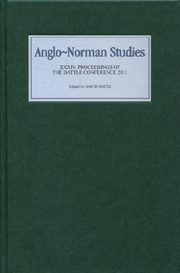Book contents
- Frontmatter
- Contents
- LIST OF ILLUSTRATIONS AND TABLES
- EDITOR'S PREFACE
- ABBREVIATIONS
- Mints and Money in Norman England
- Literate Sociability and Historical Writing in Later Twelfth-Century England
- The Archbishopric of Canterbury and the So-called Introduction of Knight-Service into England
- Lastingham and the Architecture of the Benedictine Revival in Northumbria
- ‘Lanfranc of Bec’ and Berengar of Tours
- The Invention of the Manor in Norman England
- Herbert Losinga's Trip to Rome and the Bishopric of Bury St Edmunds
- Le récit de Geoffroi Malaterra ou la légitimation de Roger, Grand Comte de Sicile
- The Two Deaths of William Longsword: Wace, William of Malmesbury, and the Norman Past
- The Beasts Who Talk on the Bayeux Embroidery: The Fables Revisited
- The Piety of Earl Godwine
The Archbishopric of Canterbury and the So-called Introduction of Knight-Service into England
Published online by Cambridge University Press: 05 April 2013
- Frontmatter
- Contents
- LIST OF ILLUSTRATIONS AND TABLES
- EDITOR'S PREFACE
- ABBREVIATIONS
- Mints and Money in Norman England
- Literate Sociability and Historical Writing in Later Twelfth-Century England
- The Archbishopric of Canterbury and the So-called Introduction of Knight-Service into England
- Lastingham and the Architecture of the Benedictine Revival in Northumbria
- ‘Lanfranc of Bec’ and Berengar of Tours
- The Invention of the Manor in Norman England
- Herbert Losinga's Trip to Rome and the Bishopric of Bury St Edmunds
- Le récit de Geoffroi Malaterra ou la légitimation de Roger, Grand Comte de Sicile
- The Two Deaths of William Longsword: Wace, William of Malmesbury, and the Norman Past
- The Beasts Who Talk on the Bayeux Embroidery: The Fables Revisited
- The Piety of Earl Godwine
Summary
The core of this article is a commentary upon four pre-Conquest documents, which are printed in part or in full in the Appendix, pp. 60–62. The first (1) is the only surviving Anglo-Saxon archiepiscopal will, that of Archbishop Ælfric (995–1005), which was preserved at Abingdon; the other documents all come from the archive of Canterbury cathedral. Two of these (2 and 3) are from the pontificate of Archbishop Æthelnoth (1020–38), who was remembered at Canterbury particularly because he was the first archbishop to be elected from within the Christ Church community since the election of Archbishop Wulfred in 805, more than two centuries earlier. The first of the Christ Church documents (2) is a royal ‘writ’ seemingly establishing the newly consecrated Æthelnoth in possession of the landed rights of his see in 1020; the second (3) is a lease in the name of the same archbishop of a tiny property from the demesne of the archiepiscopal manor of the minster of Reculver (Kent). The third Canterbury document (4) is a royal writ to Archbishop Stigand, which is included here to permit comparisons with the writ to Æthelnoth. This writ still bears the genuine seal of Edward the Confessor, though as we shall see that proof of authenticity has not prevented the text of all but the first three lines from being erased and fraudulently rewritten at the close of the eleventh century or beginning of the twelfth.
- Type
- Chapter
- Information
- Anglo-Norman Studies 34Proceedings of the Battle Conference 2011, pp. 41 - 62Publisher: Boydell & BrewerPrint publication year: 2012

